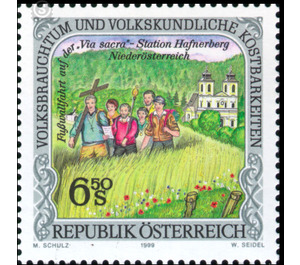folklore - Austria / II. Republic of Austria 1999 - 6.50 Shilling
Theme: Art & Culture
| Country | Austria / II. Republic of Austria |
| Issue Date | 1999 |
| Face Value | 6.50 |
| Color | multi-colored grey |
| Printing Type | combination printing |
| Stamp Type | Commemorative |
| Item Type | Stamp |
| Chronological Issue Number | 1618 |
| Chronological Chapter | OOS-OE2 |
| SID | 279817 |
| In 47 Wishlists | |
Special stamp series pilgrimages and pilgrimages means in all religions: to go to a sacred place for the sake of piety, gratitude or need of help - individually or in community with other persons. Over the centuries, pilgrimages have developed into a popular custom that is deeply rooted in the minds of people, often independently and in addition to official forms of worship. The most important place of pilgrimage in Austria is Mariazell in Styria. 1157 sent the abbot of the Upper Styrian Benedictine monastery of St. Lambrecht the monk Magnus in the then lonely forest area as a pastor for the working there wooden servants. He set up a small cell and set up the statue of Mary brought with her, hence the name Maria-Zell. The then Bishop of Vienna, Cardinal Melchior Klesl, as the dean of St. Stephen in 1587, introduced the custom of yearly pilgrimages to Mariazell. The starting point was on 11th August the Paulanerkirche. From there they moved via Brunn am Gebirge by the Brühl to Gaaden, then it went over Heiligenkreuz, Alland to Altenmarkt. The next day they arrived in Hainfeld and spent the night in Lilienfeld. On we went to Türnitz, Annaberg and Wienerbrückl. The 14th of August began at the Josefsberg and then we finally came to Mariazell, where the pilgrims were welcomed with flags and music. After a solemn Mass on the 15th of August, the feast of the Assumption of the Virgin Mary and a communal lunch, they made their way home. The special postage stamp shows a group of pilgrims on the traditional Wallfahrerweg with the pilgrimage church on the Hafnerberg in the background.


